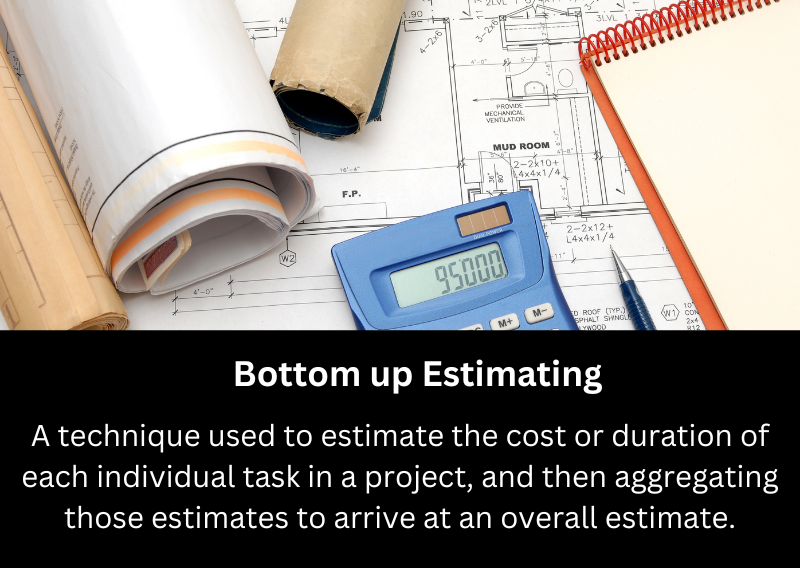Bottom up Estimating
Bottom-up estimating is a project management technique used to estimate the cost or duration of a project by breaking it down into smaller, more manageable components. It involves estimating the cost or duration of each individual task or activity in the project, and then aggregating those estimates to arrive at an overall project estimate.
Bottom-up estimating is a project management technique used to estimate the cost or duration of a project by breaking it down into smaller, more manageable components. It involves estimating the cost or duration of each individual task or activity in the project, and then aggregating those estimates to arrive at an overall project estimate.

This technique is often considered more accurate than top-down estimating, which involves estimating the project as a whole and then breaking it down into smaller components. Bottom-up estimating takes into account the details of each task or activity, allowing for a more accurate and precise estimate.
To use bottom-up estimating, project managers typically create a detailed work breakdown structure (WBS) that identifies all the tasks and activities needed to complete the project. They then estimate the cost or duration of each task or activity based on their experience or input from subject matter experts. The estimates for each task are then aggregated to arrive at an overall estimate for the project.
An example Bottom up estimate for a construction project
Let's say you're a construction project manager tasked with estimating the cost and duration of building a house. You break down the project into the following tasks:- Site preparation (Task 1)
- Foundation construction (Task 2)
- Framing (Task 3)
- Roofing (Task 4)
- Electrical and plumbing installation (Task 5)
- Insulation and drywall (Task 6)
- Flooring installation (Task 7)
- Interior and exterior finishing (Task 8)
- Task 1 - Site preparation: 1 week, $2,500
- Task 2 - Foundation construction: 3 weeks, $12,000
- Task 3 - Framing: 4 weeks, $16,000
- Task 4 - Roofing: 2 weeks, $8,000
- Task 5 - Electrical and plumbing installation: 3 weeks, $12,000
- Task 6 - Insulation and drywall: 2 weeks, $8,000
- Task 7 - Flooring installation: 1 week, $4,000
- Task 8 - Interior and exterior finishing: 3 weeks, $12,000
Total duration: 19 weeks
Total cost: $74,500
This bottom-up estimate provides a more detailed and accurate breakdown of the time and cost required for each task involved in the building project. This information can help you better plan and manage the project, allocate resources, and ensure that the project stays within budget and on schedule.
While bottom-up estimating can be time-consuming, it can help ensure that the project stays within budget and is completed on time by providing a more accurate estimate of the resources required for each task.
See all project management words
Methodology specific dictionaries / glossaries
- View the Agile Dictionary
- Managing Successful Programmes (MSP) Dictionary
- Prince 2 glossary of terms
- Full ITIL glossary of terms
- See also Risk Management Dictionary.

